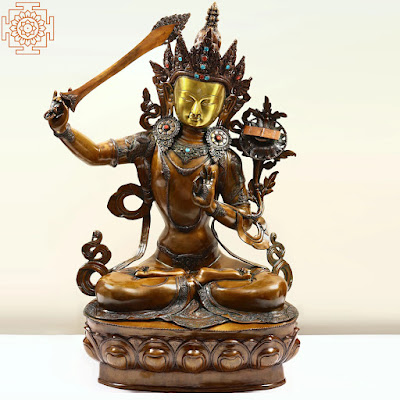This forty-inch high and twenty-six inch wide brass image represents one of the early forms of Manjushri, the Buddhist god who stands for wisdom and knowledge, more particularly the knowledge of linguistics and grammar. The image of the deity, with its two arms and the book Prajnaparmita, carried over a lotus, pursues initial idiom of Manjushri imagery.
One of the would-be Buddha’s, Manjushri also
symbolised, like other Bodhisattvas Avalokiteshvara,
Metreya, Padmapani, etceteras, different stages of soul's attainment of
Buddhattva. In early innovations, Manjushri images had
normal two arms, and only rarely four, carrying in one of them a 'khadaga', sword,
and in the other the book Prajnaparmita.
Sometimes the book was carried over a lotus, and the arm other than
the one, which carried 'khadaga', had a diamond Ratna-mani or Chintamani, which
symbolised truth, as like truth, it neither rusted nor defaced or eroded.
With
the sword, Manjushri is conceived as eliminating darkness, and with the book,
as spreading true knowledge.
 |
| Manjushri - Bodhisattva Tibetan Buddhist Deity |
Later,
when Manjushri emerged as one of the main Tantrika deities, particularly in
Tibetan Buddhism widely pursued in the northern regions of Himalayan hills, the
anatomical and iconographic perception of the image underwent a radical change.
Now the image was multi-armed, the number of arms varying from four to
eighteen. 'Khadaga' and the book were still the essentials of Manjushri
iconography, but now it also carried many other attributes 'Ratna-mani',
'abhaya', 'varada', 'vajra', 'danda', mace, battle-axe, pot, rosary, noose,
flames of fire, and many others. They symbolised his multifarious role, which
as the Tantrika deity Manjushri was invoked to accomplish.
This
exquisitely executed and exceptionally bejewelled image has been rendered with
a broad forehead, as broad face but narrowing down to chin with an angular
thrust, and half-closed eyes, as in meditation. The iconography, adornment and
costume are characteristically Tibetan. Normally, Boddhisattva images,
including Manjushri, carry in their coiffeur effigies of Dhyani, or meditating,
Buddha, but in this image the effigy has been substituted with a crest of
diamonds rising flower-like from a three-leaf base. Three leaves of the base
and five petals of the crest make eight; three symbolising, perhaps, three
basic rules of Buddhism, and eight, the
eight-fold path of the Dhamma.
The
deity is seated on a high and beautifully designed lotus 'pitha'. He is in
padmasana. The auspicious marks of lotus, carved on upward raised feet, as also
on palms, further enhance the auspice that a lotus creates. The image is
carrying in his right hand the 'khadaga'. Its handle consists of 'vajra', and
the point of the blade, of the flames of fire, obviously because fire and
'vajra' are other usual elements of Manjushri iconography. In the other hand,
he is carrying a small object, which may be 'Ratna-mani'. From under this arm
there rises a lotus stalk with a lotus on its apex. The lotus carries on it the
book. The large circular 'kundalas', ear-ornaments, correspond to 'Dharma-chakra',
often comprising part of 'prabha', not included here. A lavish and richly
bejewelled crown with seven leaves adorns the deity head, and an as rich
'khata', the sacred scarf, wraps his shoulders. A mild 'trivali', three-fold
form, defines the neck. 'Dhoti', sash, girdle on the waist, necklaces and other
ornaments are richly designed.
This
description by Prof. P.C. Jain and Dr Daljeet. Prof. Jain specializes on the
aesthetics of ancient Indian literature. Dr Daljeet is the chief curator of the
Visual Arts Gallery at the National Museum of India, New Delhi. They have both
collaborated on numerous books on Indian art and culture.
Comments
Post a Comment